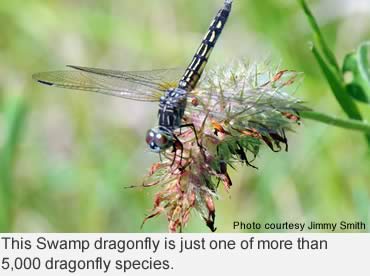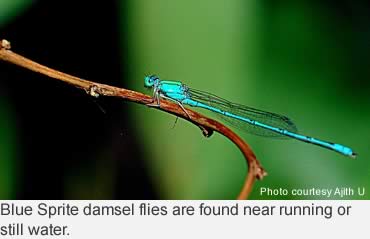In mid- to late summer, we often marvel at the dragonfly stunt pilots we find near bodies of fresh water. They’re beautiful, entertaining and intriguing.
“People are fascinated with finding dragonflies and damselflies,” says David True, refuge ranger at Aransas National Wildlife Refuge in Texas. “It’s is a growing thing.”
Dragonflies are indicators of healthy, clean water and provide natural mosquito controls. Their unique, delicate life cycle is dependent upon water. But that’s not what we find so fascinating about these aggressive aerial insectivores. It’s their ability to accelerate at the speed of lightning.
Dragonflies are unmatched in their ability to fly any direction at more than 30 mph—straight up, straight down, forward and backward, before they pause, make an abrupt stop and hover or cruise like a helicopter.
 Because nearly all of a dragonfly’s head is eyes, they also have fantastic vision. The only place they can’t see is right behind themselves.
Because nearly all of a dragonfly’s head is eyes, they also have fantastic vision. The only place they can’t see is right behind themselves.
Like aerial insectivorous bats, which also consume hoards of mosquitoes, dragonflies have long been a source for human interest in aerodynamic study and design. If only a man-made airplane could maneuver through the sky the same way . . .
Dragonflies, which are neither dragons or flies, have flashy names and flashy colors. Males wear brilliant metallic neon colors in blue, green, red, pink and yellow, while females are less colorful. They are called Darners and Dashers, Skimmers and Cruisers, Gliders, Boghunters and Meadowhawks, Sand Dragons, Snaketails, Ringtails and Spiketails, Pilots, Phantoms and Swamp Cruisers, to name a few of the more than 5,000 known species.
They are sometimes confused with their biological cousins, damselflies, which have a similar body structure, because both are ancient members of the Odonata species, with a family tree that dates from 300 million years ago.
It’s difficult to tell them apart. A damselfly’s body is quite slender, and there is more space between their eyes; their wings are similar, but when at rest, a dragonfly holds its two sets of wings open while a damselfly closes and folds its wings over its abdomen. There are also many more dragonflies than damselflies.
 They are skilled predators and eat any insect they can catch, while flying. Dragonflies need to fly to eat. Besides mosquitoes and midges, they also eat butterflies, moths, bees, flies and other dragonflies, often consuming their own body weight in prey every day.
They are skilled predators and eat any insect they can catch, while flying. Dragonflies need to fly to eat. Besides mosquitoes and midges, they also eat butterflies, moths, bees, flies and other dragonflies, often consuming their own body weight in prey every day.
They are not very big insects but their translucent wing spans can range between two and five inches while their body weight is just .014 ounce.
They will always be found near water. Their eggs are deposited in water, and their larvae, or nymphs, are also highly predatory and completely aquatic.
Both dragonflies and damselflies depend on high-quality wetland habitat throughout their life cycles, another reason why wetlands that filter water, absorb pollutants and manage flooding support wildlife as well as fascinating insect life.
Several states conduct dragonfly studies and counts, and several national wildlife refuges note that dragonfly observation is a growing interest to visitors.
Besides the Aransas National Wildlife Refuge in Texas, other ranges popular with dragonfly watchers include the Desert National Wildlife Refuge Complex in southern Nevada where 43 species of dragonflies and damselflies have been documented, Bitter Lake National Wildlife Refuge, New Mexico, and Patoka River National Wildlife Refuge, Indiana.
Resources: Ohio Odonata Survey/Ohio Division of Wildlife; USFW Refuges.